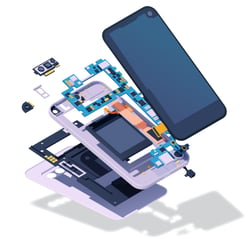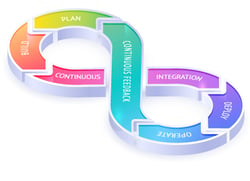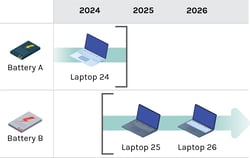 The manufacturing process is complex in scope, strategy, and systems. While innovation can transform every process step from the manufacturing floor to the products themselves, it also adds to the complexity of physical product development. Products require the involvement of more stakeholders than before, bringing together many different opinions, timelines, roadmaps, and requirements.
The manufacturing process is complex in scope, strategy, and systems. While innovation can transform every process step from the manufacturing floor to the products themselves, it also adds to the complexity of physical product development. Products require the involvement of more stakeholders than before, bringing together many different opinions, timelines, roadmaps, and requirements.
How did we get here, and what does the future of product roadmapping look like for manufacturing? In this article, we will look at the evolution of product roadmapping and the rise of Agile to analyze the current best practices for success.
Key Definitions
Before we dive into the history and evolution of Agile product roadmapping, let's explore the root definitions of these terms for clarity.
What Is the Product Roadmap?
 The product roadmap guides a product through every stage of its life cycle, from the original idea to design and development to production and launch to eventual sunset. Depending on the complexity and scope of the product, a product roadmap can take several months or years. While each product needs an individual roadmap, it should also connect to the related product line and larger product portfolio, which is typically managed within product roadmap management software.
The product roadmap guides a product through every stage of its life cycle, from the original idea to design and development to production and launch to eventual sunset. Depending on the complexity and scope of the product, a product roadmap can take several months or years. While each product needs an individual roadmap, it should also connect to the related product line and larger product portfolio, which is typically managed within product roadmap management software.
The roadmap is the central communication piece at every step of the product development process, whether the product is software, hardware, or a cyber-physical combination.
What Does Agile Mean in the Context of Manufacturing?
 The Agile methodology prioritizes customer satisfaction by delivering valuable features early on and frequently. This allows for quick adjustments based on changing requirements and feedback. Because continuous improvement is central to this approach, teams must reflect on their processes and make changes to improve efficiency and quality.
The Agile methodology prioritizes customer satisfaction by delivering valuable features early on and frequently. This allows for quick adjustments based on changing requirements and feedback. Because continuous improvement is central to this approach, teams must reflect on their processes and make changes to improve efficiency and quality.
The Agile mindset values people and their interactions over processes and tools. The focus is on collaborations, seeking customer feedback, and solving problems to meet customer needs in rapidly changing environments. The method also involves breaking down projects into smaller parts called iterations or sprints. In these Agile settings, cross-functional teams work closely together throughout the development process.
While Agile was first conceptualized as a product development approach for software companies, it has been adapted for manufacturing and large organizations with scaled frameworks like SAFe.
What Is Involved in Agile Product Roadmapping?
We've highlighted the significance of the product roadmap and explored the concept of Agile in the manufacturing context. Now, let's look at the meaning of agile product roadmapping. Agile product roadmapping is a dynamic process for planning, prioritizing, and communicating a product's direction over time. It involves creating and maintaining a flexible plan that adapts to changes in market conditions, customer feedback, and business goals.
An Overview of Traditional Product Roadmapping
 Before the great disruption of software products and digital components, traditional product roadmapping followed a straightforward, rigid approach. The traditional way of planning products followed a step-by-step strategy shaped by stages and approvals or gates, hence the name Stage-Gate or Waterfall when it comes to project management. The Stage-Gate approach was so successful for so long that many manufacturing companies still follow this approach as their primary product development methodology.
Before the great disruption of software products and digital components, traditional product roadmapping followed a straightforward, rigid approach. The traditional way of planning products followed a step-by-step strategy shaped by stages and approvals or gates, hence the name Stage-Gate or Waterfall when it comes to project management. The Stage-Gate approach was so successful for so long that many manufacturing companies still follow this approach as their primary product development methodology.
The Strengths of the Stage-Gate Approach
The appeal of the Stage-Gate approach is that it feels like a safe strategy for developing and launching a product. Product teams would research the best prospective idea and develop a full business case for approval before designing anything. Only when the idea was approved did teams go away and build a fully functioning prototype to test, analyze, and perfect. Once the prototype was approved, production started, and there was no changing or adding to the product scope.
The pace of product development using the Stage-Gate approach is slower than Agile, but it works well to minimize risk, align teams to a workflow, and ensure complex plans stay on track. Thoroughly researching and defining a product before production helps companies feel confident in their decisions to approve an idea.
Traditional product roadmaps are less dynamic than Agile roadmaps. In Stage-Gate roadmaps, milestones occur at the approval points, and details are added as each stage progresses. Overall, products followed a fairly predictable path from design to launch.
Challenges in Traditional Planning Methods
 Stage-gate methods may have several proven benefits, but they also present challenges, especially for highly complex cyber-physical products. With software integration into hardware, different product teams are coming together to collaborate and align their workflows. When software development teams work in Agile and hardware component teams work with Stage-Gate, there needs to be a process to align their workflows.
Stage-gate methods may have several proven benefits, but they also present challenges, especially for highly complex cyber-physical products. With software integration into hardware, different product teams are coming together to collaborate and align their workflows. When software development teams work in Agile and hardware component teams work with Stage-Gate, there needs to be a process to align their workflows.
In some scenarios, manufacturers can adopt a version of Agile so that all their teams can sync the approaches. For most manufacturers of complex products, the best solution is to follow a hybrid approach that syncs cadences between Agile teams and Stage-Gate teams while keeping the systems that make sense for each group.
Often, the biggest hurdle manufacturer faces is adapting their mindset to the Agile approach.
The Emergence of Agile Methods
 The exact origin of Agile methods is debatable, but what is clear is that the approach largely took off at the turn of the 21st century. Since then, the pace at which new products launch has increased dramatically. Companies that follow the traditional product planning approach without adapting in any way to modern markets find themselves outpaced by innovation, customer needs and demands, and their competitors.
The exact origin of Agile methods is debatable, but what is clear is that the approach largely took off at the turn of the 21st century. Since then, the pace at which new products launch has increased dramatically. Companies that follow the traditional product planning approach without adapting in any way to modern markets find themselves outpaced by innovation, customer needs and demands, and their competitors.
The rise of software, digital products, and industry changes fed the need for Agile product roadmapping to match the rapid evolution of product design and development. Product roadmaps that are dynamic, always up-to-date, and able to connect diverse stakeholder teams help companies stay competitive in the age of Agile.
Principles of Agile Product Management
Several key principles guide enterprise Agile product management, emphasizing flexibility, customer-centricity, collaboration, and continuous improvement. Here are the core principles:
- Customer Value: The primary focus of agile product management is to deliver value to customers. This means understanding customer needs, preferences, and pain points and prioritizing features and improvements that provide the most value.
- Iterative Development: Agile product management emphasizes iterative development. This approach allows for faster delivery of value and enables the product to evolve based on real-world feedback.
- Cross-Functional Collaboration: Agile product management encourages collaboration between cross-functional teams, including developers, designers, testers, and stakeholders. Sharing knowledge, ideas, and feedback leads to better solutions and faster delivery.
- Continuous Feedback: Feedback is essential in agile product management. This includes feedback from customers, stakeholders, and team members. By continuously gathering feedback, product managers can validate assumptions, identify areas for improvement, and ensure that the product meets customer needs.
- Prioritization: Product managers must prioritize features and initiatives based on their value to the customer, business goals, and market needs. Techniques such as user story mapping, impact mapping, and the MoSCoW method help prioritize effectively.
- Adaptability: Agile product management embraces change. Product managers should be able to adapt to changing market conditions, customer feedback, and business priorities. This means being flexible in adjusting the product roadmap and priorities as needed.
- Minimal Viable Product (MVP): Agile product management advocates for building and releasing a Minimal Viable Product (MVP) early to gather feedback and validate assumptions. An MVP is the simplest version of the product that delivers value to customers. It allows teams to learn quickly and make informed decisions about future development.
- Continuous Improvement: Agile product management promotes a culture of continuous improvement. Teams regularly reflect on their processes, tools, and outcomes and seek ways to improve.
Using Agile Product Roadmaps
Throughout history, products that did not experience frequent innovation had fairly fixed plans from concept to production to sale. It's only since the relatively recent explosion of technology that customer demand has shifted to new, customizable, and constantly updated options.
The only way to adapt to the consumer's needs and wants is to have product plans and roadmaps that mirror those frequent changes and updates. Since the roadmap is the guide for the product, Agile product roadmaps are necessary to guide Agile product development.
Transitioning from Fixed Plans to Adaptive Planning
Adopting Agile product planning starts by transitioning away from fixed product plans to adaptive planning strategies. Rather than creating a detailed plan upfront, Agile product roadmapping focuses on creating a high-level plan that evolves over time through iterative and incremental updates. This allows product teams to respond to change and adjust the roadmap based on new insights, feedback, or shifts in business priorities.
Building Greater Collaboration Between Teams
 Adaptive planning involves cross-functional collaboration between product managers, development teams, product stakeholders, and sometimes customers. Incorporating more voices into the product planning process ensures that the customer's voice is heard and innovation is encouraged from all teams. In turn, these collaborations incorporate the needs and priorities of all stakeholders in the roadmap.
Adaptive planning involves cross-functional collaboration between product managers, development teams, product stakeholders, and sometimes customers. Incorporating more voices into the product planning process ensures that the customer's voice is heard and innovation is encouraged from all teams. In turn, these collaborations incorporate the needs and priorities of all stakeholders in the roadmap.
Incorporating Customer Feedback Loops
Customer feedback is more important than ever in Agile product roadmaps. Companies need to balance between delivering on the customer demands while also staying in tune with the unspoken needs customers will want in the future. Quick adaptations while simultaneously encouraging ground-breaking innovation is a universal challenge manufacturers face. Regular customer feedback loops make it possible.
Focusing More on Prioritization
Product teams prioritize what goes on the roadmap based on customer value, business impact, and feasibility. Prioritization is often done using techniques such as user story mapping, impact mapping, or scoring methods such as the WSJF (Weighted Shortest Job First) formula or the MoSCoW method (Must have, Should have, Could have, Won't have). With road mapping tools like Gocious, teams can conduct prioritization in one dashboard and easily move the product plans directly to the roadmap.
Creating Alignment with Strategy
While agile product roadmaps are flexible, they still need to align with the overall strategic goals of the organization. This alignment ensures that the product remains focused on delivering value and contributing to the organization's goals and objectives.
Using Visual Representation
Agile product roadmaps work best in visual formats, using tools like Gantt charts, Kanban boards, or simple lists. This visualization helps communicate the product plans effectively across teams and stakeholders. When each team has access to the roadmaps with customized views that only show the details they need to see, everyone can stay informed at all stages of product development.
Aligning Time Horizons
 Agile roadmaps typically focus on short-term goals and outcomes, usually spanning a few weeks to a few months. This allows for quick adjustments and adaptation to changing circumstances. These shorter timelines work well for the software side of the product while creating a need for alignment with the hardware of the physical product side. Agile product roadmaps that are set with intention can sync cadences between teams to ensure all pieces of the product come together at the right moments.
Agile roadmaps typically focus on short-term goals and outcomes, usually spanning a few weeks to a few months. This allows for quick adjustments and adaptation to changing circumstances. These shorter timelines work well for the software side of the product while creating a need for alignment with the hardware of the physical product side. Agile product roadmaps that are set with intention can sync cadences between teams to ensure all pieces of the product come together at the right moments.
Iterating and Improving Continuously
Agile product roadmaps are not static documents; they are continuously reviewed and adapted based on new information, feedback, and insights gathered during the development process. Just as the product is tested, reviewed, and improved continuously, so are the roadmaps.
Agile Methods Benefit All Your Manufacturing Teams
When your company implements Agile product roadmaps, it benefits not only your product management teams but all teams with a stake in the process.
Inform Your Sales Teams
Agile roadmapping makes it easier to share information about your products with your sales teams and adjust any plans based on research and feedback from those teams. Having access to the roadmap also provides sales teams with visibility into upcoming product features and release dates. This helps them align their sales strategies and pitches accordingly. While Agile allows for flexibility, it also provides a predictable release schedule, helping sales teams plan their activities and forecasts more accurately.
Align Your Marketing Teams
 Marketing teams need to know all the release plans for upcoming features in order to market and plan advertising campaigns ahead of schedule. Without proper marketing, you'll have a tougher time selling your product. Agile road mapping ensures that marketing teams are aware of upcoming features and releases, allowing them to plan marketing campaigns and strategies accordingly.
Marketing teams need to know all the release plans for upcoming features in order to market and plan advertising campaigns ahead of schedule. Without proper marketing, you'll have a tougher time selling your product. Agile road mapping ensures that marketing teams are aware of upcoming features and releases, allowing them to plan marketing campaigns and strategies accordingly.
Knowing what customers are saying about your product is also essential to revising and improving your offerings. Marketing teams can provide valuable customer feedback to product development teams, helping to shape future iterations of the product. Agile enables marketing teams to quickly adapt their messaging and campaigns based on changes in product development or market needs.
Collaborate with Engineering
 Engineering teams need clarity to help them focus on what's most important for the product and the business. Agile roadmaps provide clear priorities for all stakeholders and allow engineers to adapt to changes more easily. When new iterations are needed, and engineers can make them happen, then your whole team can become more customer-focused in development.
Engineering teams need clarity to help them focus on what's most important for the product and the business. Agile roadmaps provide clear priorities for all stakeholders and allow engineers to adapt to changes more easily. When new iterations are needed, and engineers can make them happen, then your whole team can become more customer-focused in development.
Cross-functional teams must work together to promote a culture of continuous improvement. When they do work together, innovation is more likely to happen. Engineers can contribute to these collaborations and innovations by iterating on features and functionality based on collected feedback.
Provide Transparency to Executives
Executives need and want to know what's being worked on, what's next in the plans, and the overall progress of items in the product portfolio. Agile roadmaps provide executives with transparency into the product development process. Agile makes identifying issues and risks easier, enabling executives to make informed decisions and mitigate risks more effectively.
Agile Product Roadmapping Tools for Dynamic Markets
Overall, Agile product roadmapping fosters collaboration, transparency, adaptability, and customer focus, benefiting all stakeholders, including sales, marketing, engineering, executives, and product management teams alike.
Keeping up with dynamic markets means your product stakeholders need the right tools to help them evaluate the product portfolio, test new ideas, and adapt the roadmap as they go. Gocious product roadmap management software is key to creating flexible roadmaps that guide product development and keep teams aligned to the bigger goals. Book your free demo to see how Gocious PRM software can work for your team.


